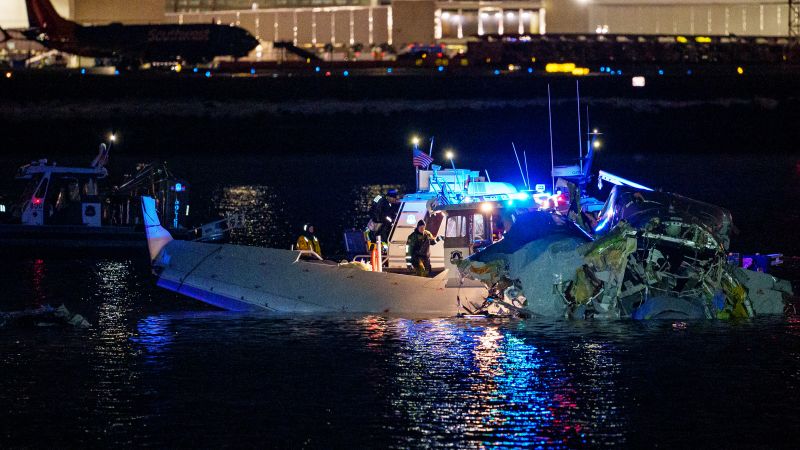[Families Waiting for Loved Ones When Plane Collides with Military Helicopter in Deadly Explosion
Families were waiting at the airport to welcome home loved ones when their plane, just minutes from landing, collided midair with a military helicopter in a fiery explosion, plunging 67 lives full of promise into the cold, inky waters of the Potomac River.
The frantic search for survivors started under the cloak of icy darkness. By morning, the mission had turned into a slow and somber search for the remains of everyone on board. At least 42 bodies, 38 of which have been identified, have been recovered from the murky depths of the Potomac, with near-zero visibility in the frigid water, sharp pieces of debris, and the mangled metal of the wreckage hampering the search effort.
Amid heated political speculation on the cause of Wednesday night’s collision and grief-stricken stories from heartbroken loved ones, hundreds of rescue personnel continue to search relentlessly for the remains of every person lost.
“Heavier equipment needed to remove remaining bodies”
The mangled wreckage in the Potomac River has made the recovery effort especially difficult for dive teams, who have struggled to access parts of the plane’s fuselage. These sections will need to be removed to retrieve the remaining bodies, DC Fire and EMS Chief John Donnelly said.
The wreckage of the American Airlines jet broke apart, according to Secretary of Transportation Sean Duffy. The fuselage was found upside down in three sections in the river, which is about 8 feet deep in some areas. Divers have been using specialized underwater hydraulic rescue tools capable of cutting metal to try to recover as many victims as possible, Hoagland said.
A US Coast Guard boat equipped with a crane was used on Friday to hold the door of the US Army Black Hawk helicopter, allowing for the retrieval of the bodies of all three service members, followed by the “dignified transfer of their remains,” Hoagland said.
The recovery effort has been extensive, involving nearly every dive team in the area, including the US Coast Guard, the FBI’s Washington Field Office dive team, DC Fire and the International Association of Fire Fighters.
” Dangerous, difficult, and risky conditions”
When a direct line to Reagan National Airport rang that Wednesday night, Hoagland said Local 36 first responders expected a routine report of a flight in distress. Instead, they heard: “Crash! Crash! Crash!” he recalled. As union members rushed to a pier to board a fireboat, burning debris rained down over the Potomac. First responders arrived to find wreckage submerged in the shallow water and almost immediately started finding victims, Hoagland said.
Rescue teams are planning to bring a larger crane to the Potomac River crash site to help reach victims in a section of the wreckage divers can’t access, a law enforcement source told CNN.
On the night of the crash, emergency crews battled icy, choppy waters, Chief Donnelly said. “The water is dark, it is murky, and that is a very tough condition for them to dive in. If you can imagine, the river is a large black spot at night with no lights on it, except for a few buoy lights,” Donnelly said.
“First responders and emergency personnel, who have been working around the clock for days — first desperately searching for survivors, and now tragically recovering remains — are exhausted, Hoagland said, but remain resilient. Everybody just really wants to see things through. We’re looking out for each other, and everybody’s getting breaks.”
To support first responders dealing with the trauma of what they’re witnessing on the scene, the International Association of Fire Fighters has deployed teams of former firefighters trained as mental health counselors to assist with ongoing recovery efforts.
The National Transportation Safety Board will allow first responders to complete their work before beginning its investigation into the deadly collision, the board’s chair said on Thursday.
Source link

